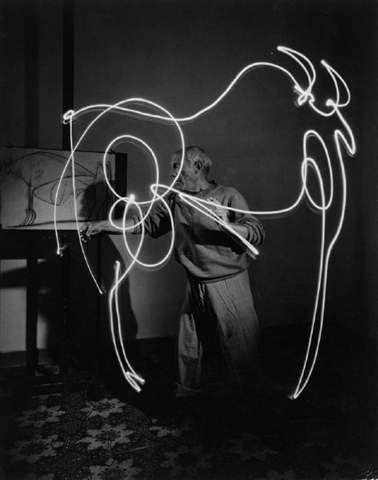How do we see cleaning?
 Photo by Gjon Mili, from Life Magazine, September 9, 1946, originally printed with the caption, "Pattern of light streaks show how an efficient housewife makes a bed."
Photo by Gjon Mili, from Life Magazine, September 9, 1946, originally printed with the caption, "Pattern of light streaks show how an efficient housewife makes a bed."
A couple of years ago, I ran across this photograph by Gjon Mili and stared at it for a long time. It took me a few moments to puzzle out what I was seeing. To make the image, Mili had affixed a light to a woman’s hands while she made a bed in a darkened space. Leaving the camera’s shutter open for several minutes caused all of her movements to collapse into one image. That compression of time, along with the aerial perspective, seemed to ask me to take a big step back as a viewer, to try looking afresh at something as familiar as making a bed.
The photograph stuck in my mind. I started to imagine how I could make a film that would invite viewers to take that kind of “big step back” in looking at housework.
It is only at a certain distance (and from a certain angle) that we can recognize the character of the communal life of the individual – or the communal reality of those who appear so convincingly under other conditions to be individuals. – Jeff Wall
Soon I began asking people to tell me about their experiences with cleaning. I also asked them to perform some of their regular housekeeping tasks for the camera. The 91 minute film that resulted is titled MAINTENANCE. My main motivation in making the film was to have conversations about cleaning. I wanted to know how people made sense of the never-ending cycle of messing and tidying. I wanted to know whether they resented the work, the way I often do. I wanted to know what it meant in their lives. I learned a lot from these conversations, and I’ll share more thoughts about them in future posts, but for now, I want to return to that photograph by Gjon Mili that was the catalyst for the project.
Gjon Mili created the bed-making photograph in 1946 as part of a commission by Life Magazine to illustrate efficient housekeeping techniques (September 9, 1946, p.97-107). A few years later, Mili used a similar technique to make time-lapse photographs of Pablo Picasso drawing with light.
 The photographs of Picasso drawing with light are familiar. They are famous representations of his virtuosic artistry, the kind of thing you find on a postcard in a museum gift shop. It’s interesting to ponder what the arcing line of light in the photograph of Picasso represents, as compared to the squiggly line of light in the photograph of the woman making the bed. Both represent movements of the hand, but the work Picasso performs is much more highly valued than the work performed by the housewife. These photographs represent two sides of a dichotomy that is deeply rooted in Western culture: creation, immortality, genius, and spirit on one side; and maintenance, the ephemeral, grunt work, and the body on the other side. Part of the purpose of this project is to explore this dichotomy, and all of the other cultural conceptions we bring to the work of keeping house.
The photographs of Picasso drawing with light are familiar. They are famous representations of his virtuosic artistry, the kind of thing you find on a postcard in a museum gift shop. It’s interesting to ponder what the arcing line of light in the photograph of Picasso represents, as compared to the squiggly line of light in the photograph of the woman making the bed. Both represent movements of the hand, but the work Picasso performs is much more highly valued than the work performed by the housewife. These photographs represent two sides of a dichotomy that is deeply rooted in Western culture: creation, immortality, genius, and spirit on one side; and maintenance, the ephemeral, grunt work, and the body on the other side. Part of the purpose of this project is to explore this dichotomy, and all of the other cultural conceptions we bring to the work of keeping house.
 Adele Horne Posted on
Adele Horne Posted on  Saturday, December 8, 2012 at 5:41PM
Saturday, December 8, 2012 at 5:41PM 


Reader Comments